#high brightness LCD display
Explore tagged Tumblr posts
Text
High brightness LCD displays have revolutionized digital screen technology, offering unparalleled clarity and visibility in various lighting conditions. Whether used in outdoor kiosks, industrial applications, or commercial signage, these displays ensure content remains readable even in direct sunlight.
0 notes
Text
Unleash Creativity with Square LCD Screens
Unleash your creativity and transform your displays with our square LCD screens. Designed for versatility and visual impact, these displays offer a unique canvas for your content, whether you're creating digital art installations or interactive exhibits. With vibrant colors, high resolution, and customizable options, our square LCD screens empower you to bring your vision to life with precision and clarity. Explore our collection and unlock new possibilities with Rondeli Display's innovative solutions. Visit our website to learn more: Square LCD Screen.
#TFT LCD Module#TFT Modules#bar type lcd display#High Brightness LCD#Touch Panel Display#lcd touch screen#Capacitive Touch Screen#lcd display screen#Monochrome Display#Square LCD Screen
2 notes
·
View notes
Text
A Practical Guide to Customizing TFT LCD Displays for Embedded Projects
When designing an embedded system, picking the right display module is more than a technical choice — it directly shapes how users interact with your product.
From medical devices and HMIs to industrial controllers and smart panels, standard TFT LCD modules may not always be enough. That’s where custom displays come in — offering flexibility in electrical interface, mechanical layout, and visual performance.
This guide covers the five key areas you should consider when customizing a TFT LCD for your embedded project.
1. FPC Layout and Pin Mapping
The Flexible Printed Circuit (FPC) connects your LCD module to the mainboard, and in custom designs, this interface is often the first thing to change.
Ask yourself:
Do you need a uniquely shaped or angled FPC to fit inside your housing?
Are there ICs, resistors, or other components on the backlight or CTP that require mechanical clearance?
Is your SBC’s connector pinout compatible with the LCD’s FPC layout?
A mismatch here can lead to signal errors, mechanical stress, or even damage to components.
2. Backlight Brightness and Color Temperature
Not all embedded devices live under the same lighting.
If your product is used outdoors or in industrial lighting, consider high-brightness backlights (≥800 nits). For environments where aesthetics and color warmth matter (like smart mirrors or indoor kiosks), choose the right LED color temperature:
3000K (Warm White): Soft, suitable for medical or ambient lighting
5000K (Neutral White): Balanced tone, accurate colors
6500K+ (Cool White): Sharper, more industrial feel
A poorly lit display can make a great device feel underwhelming.
3. Touch Panel Shape and Bonding Options
If your display includes a touch interface, customizing the Capacitive Touch Panel (CTP) is critical.
Typical customizations include:
Round corners, logo cutouts, button holes
Bonding methods:
Optical bonding: Improves visibility, reduces reflections, stronger seal
Air bonding: More affordable and easier to assemble
The bonding method directly impacts touch accuracy, display clarity, and long-term reliability.
4. Surface Treatments: AG, AR, and AF
For devices exposed to bright light or frequent finger contact, display surface treatments make a noticeable difference.
AG (Anti-Glare): Scatters reflected light, improving readability
AR (Anti-Reflection): Enhances contrast in sunlight or strong lighting
AF (Anti-Fingerprint): Reduces smudges, improves touch feel
Combining AG+AF is a common choice for public-facing touchscreen displays.
5. Want to Learn More?
If you’re building with platforms like RK3566, PX30, or Allwinner boards and need a reliable display solution — including driver compatibility and electrical tuning — check out our full technical article:
👉 Read the Full Custom TFT LCD Guide
You can also browse driver/device tree examples on GitHub:
📂 rocktech-tft-display-configs
2 notes
·
View notes
Text
Puppy pinball update: These bitches played pinball in a pencil skirt and wedges.

(Ref [Img 1] for ID) We went to Belles and Chimes Toronto last night and had an absolute blast! It was so cool to get the chance to have fun playing pinball with other women. The group was so lovely and so friendly, and we felt genuinely rejuvenated by it. It was magic.
Now for the pinball part:
We placed T-7 out of 10, with 18 total points in a 4-2-1-0 scoring system across 9 games. Mathematically, that means we averaged 2nd place in our games, which is rad! Really, what happened was we won 3 games, which was a HUGE thrill. 2 fourths, 2 seconds, and 2 thirds rounded out a very delightful night! We managed to get pics of all of our wins: Attack from Mars (Bally/Williams 1993) 1,323,387,530
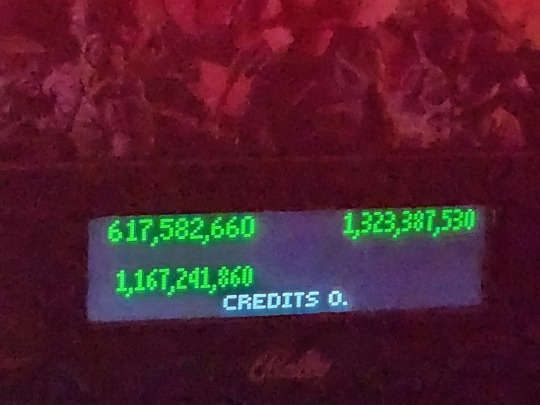
(ref [Img 2] for ID) John Wick Pro (Stern 2024) 3,817,760
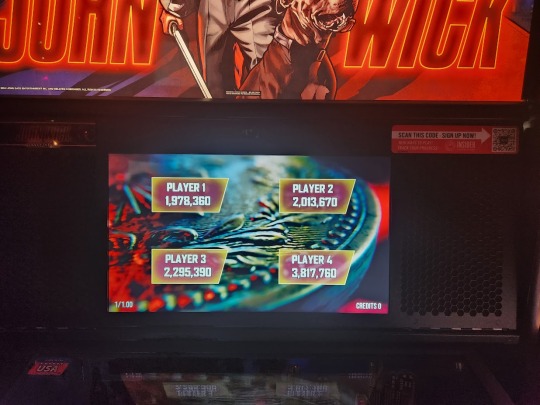
(ref [Img 3] for ID) Jurassic Park Pro (Stern 2019) 25,495,560
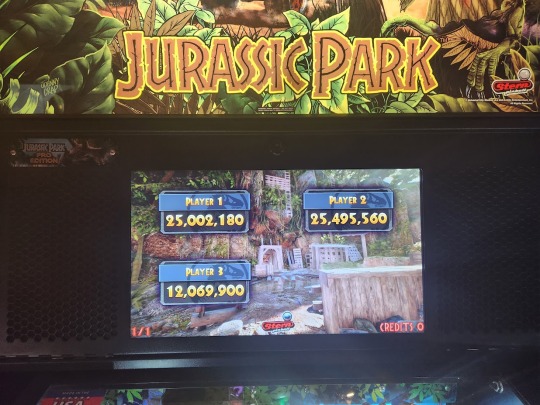
(Ref [Img 4] for ID) I can't wait for next month's tournament!
Image ID Zone
[Img 1] The cardigan system pictured from a high angle selfie shot. Her eyes are a greyish colour in the pink and red tinged light, and she's wearing a white floral pattern blouse with taupe flowers on it, and a bright red pencil skirt. Her eyes have lightly winged liner, and mascara adorning them. Her ears have trans pride Lego earrings in them. Visible on her arm is an Aurebesh tattoo that says "make brave and heroic decisions. [Img 2] A photo of the results screen from Attack From Mars. It is a dot matrix display in green. P1 has scored 617,582,660. P2 has scored 1,323,387,530. P3 has scored 1,167,241,860.
[Img 3] A photo of the results screen for John Wick (Pro). It is an LCD showing the scores of 4 players and one of the coins from the film franchise as the background. P1 has scored 1,978,360. P2 has scored 2,013,670. P3 has scored 2,295,390. P4 has scored 3,817,760
[Img 4] A photo of the results screen for Jurassic Park (Pro). It is an LCD showing the scores for three players and an empty dinosaur paddock stylized from the film franchise as the background. P1 has scored 25,002,180. P2 has scored 25,495,560. P3 has scored 12,069,900 (nice).
6 notes
·
View notes
Text
Camera Showcase
Olympus OM2 Spot Program
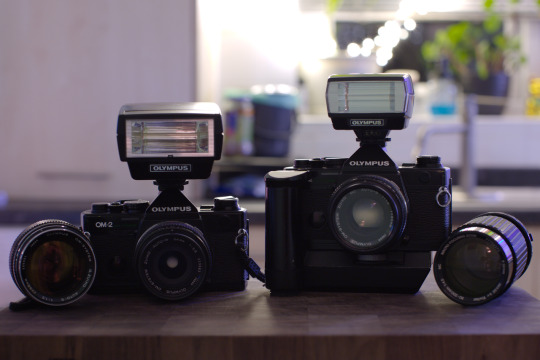
Pictured: Olympus OM2 Spot Programs with all owned OM specific lenses, flash units and motor winder
In the OM series of cameras, double digits such as the OM10 were consumer grade, whereas single digits were professional grade. First manufactured in 1984, the OM2 Spot Program (OM2S in the US) was a thorough overhaul of the OM2 to make it more competitive, meaning it's internals have more in common with the OM4 than it's predecessor.
Personally speaking, this is the most feature-rich, reliable 35mm film camera I have owned, making it my go-to workhorse for 35mm work. It’s compact design was very well-thought out and lightweight compared to other cameras before it.

Pictured: Top view of the OM2 Spot Program highlighting camera controls
One of the really well-thought out designs of this camera is how the shutter speed, aperture and depth of field preview controls are all in the same area on or next to the lens, meaning with one hand you can set all the main exposure controls without looking away from the viewfinder. Instead of a shutter speed selector on top, it’s a combined ISO speed/exposure compensation dial.
The OM2 Spot Program has 3 shooting modes: Program, Auto and Manual/Spot. In Program, the lens is set to the highest/tightest aperture and the camera will set both the aperture and shutter speed according to the light levels. In Auto, the camera shoots in an aperture priority mode where the user sets the aperture and the camera deals with the rest. In both Program and Auto modes, the camera meters centre weighted but in the full manual mode the camera switches to spot metering. This is an extremely useful feature when shooting high contrast images and with light sources behind the subject matter.
Another great thing versus it's predecessors is that it has a mechanical 1/60th shutter speed option, meaning if the batteries are depleted mid-shoot there's still a way to take photos depending on light levels.
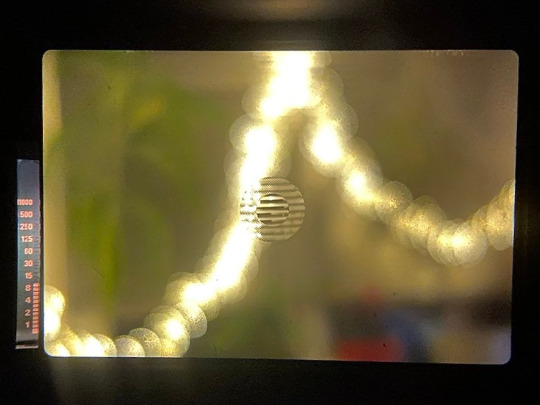
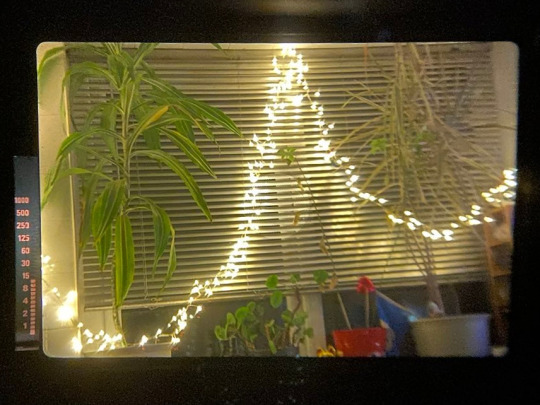

Pictured: 3 shots through the viewfinder showing the current focus screen's split centre and microprism centre, the Program/Auto mode metering and the Spot/Manual's digital match needle meter
The viewfinder's light meter is a LCD style display which can be illuminated for 90 seconds for better viewing in low light scenes. In Manual/Spot mode it switches from a bar depicting the shutter speed to a match needle style display. The viewfinder itself (dependant on chosen focus screen) is very clear and bright making composition a lot easier.

Pictured: A selection of various attachments for the OM series of cameras. teleconverters, extension tubes, right-angle viewfinder, motor winder and flash units
The OM series of cameras have a wide range of accessories to further extend the capabilities of this camera. The motor winder allows for shooting up to 3.5 frames a second in continuous mode. The right angle viewfinder is especially useful when shooting at awkward angles or with telephoto lenses on a tripod, and has a toggle switch to add a 2.5x magnification to it for really dialling in the focus. I have a T20 and T32 flash for my cameras, and although the more lightweight and smaller T20 is more portable and uses half the amount of batteries, I prefer the T32 as it allows for bounce flash photography. Both flash units have 3 modes: TTL camera auto, flash unit auto and full manual. I have only really used the TTL camera auto mode but with the lens set to f4 I haven't had any photos with blown out highlights or muddy shadows.
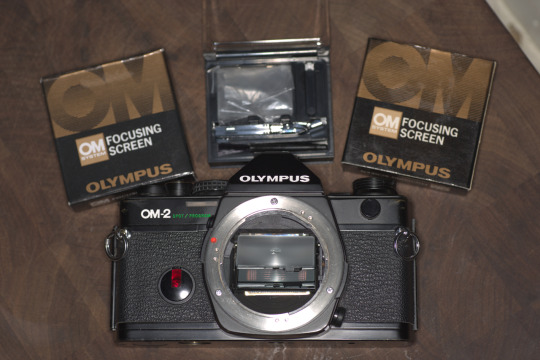
Pictured: three different focus screens and an OM2 Spot Program with no lens and the current focus screen unclipped from the camera
A great thing about the OM2 Spot Program and other single digit OM cameras is the ability to fairly easily switch focus screens. Different lenses and scenarios work better with different screens and the ability to change really increases the versatility of the camera. For example, for general use I tend to use a split centre with microprism focus screen to give me 3 ways to focus, but with a telephoto (especially with teleconverters) the split centre goes black due to the low light levels. At that point, I have the option to switch to a microprism only or ground glass screen to make it easier to focus.
All in all, a fantastic camera with a solid design, accurate light meter and a wide selection of lenses and attachments which if in good condition will be a fantastic addition to any vintage camera collection.
#photography#film photography#ishootfilm#analog photography#filmisnotdead#vintage cameras#camera review#35mm film#35mm format#reviews#retro camera#olympus camera#olympus om2sp#olympuscamera#35mm camera#analog camera#old camera#camera#om2sp
3 notes
·
View notes
Text
Tips to improve your MacBook’s Battery Performance

MacBooks have become indispensable tools for work, education, and entertainment. One important factor that often gets overlooked in the quest for the perfect MacBook’s battery life. The longevity of your MacBook's battery can significantly impact your productivity and convenience. In this comprehensive guide, we'll explore the importance of battery life and provide practical tips for finding a MacBook that offers optimal longevity.
Understanding the Significance of Battery Life:
- Productivity: Longer battery life means more uninterrupted work sessions, especially when you're on the go or in places without easy access to power outlets.
- Portability: A MacBook with extended battery life enhances portability, allowing you to work or enjoy entertainment without constantly worrying about finding a charging station.
- Cost Efficiency: Investing in a MacBook with a durable battery can save you money in the long run, reducing the need for frequent battery replacements or upgrades.
- Environmental Impact: Choosing a MacBook with a longer battery life contributes to reducing electronic waste by extending the lifespan of your device.
Is your Macbook battery draining quickly or not holding a charge? It may be time for a replacement. Contact Lappy Maker for professional battery replacement services.
Factors that Affecting Battery Life
- Battery Capacity: The size of the battery plays a significant role in determining how long your MacBook can run on a single charge.
- Hardware Efficiency: Energy-efficient components such as processors, display panels, and storage drives can help conserve battery power.
- Software Optimization: Operating system updates and power management settings can impact battery performance, with some systems offering better optimization for extended battery life.
- Usage Patterns: Your usage habits, such as running multiple applications simultaneously or streaming high-definition videos, can drain the battery more quickly.
Tips for Finding a MacBook with Long Battery Life
1. Assess Your Needs
- Determine your typical usage scenarios to understand the level of battery life required for your daily activities.
- Consider whether you prioritise performance, portability, or battery life when selecting a MacBook.
2. Research Battery Specifications
- Look for MacBooks with high-capacity batteries or those equipped with energy-efficient technologies.
- Check manufacturer specifications and reviews to get an idea of real-world battery performance.
3. Consider Battery Life Ratings
- Pay attention to battery life ratings provided by manufacturers, but keep in mind that actual usage may vary depending on usage conditions.
- Look for MacBooks with battery life that meets or exceeds your specific requirements.
4. Opt for Energy-Efficient Components
- Choose MacBooks with energy-efficient processors, such as Intel's low-power variants or AMD's Ryzen Mobile processors.
- Select SSD storage instead of traditional hard drives, as SSDs consume less power and contribute to longer battery life.
5. Evaluate Display Technology
- Consider MacBooks with energy-efficient display panels, such as LED-backlit or OLED screens, which consume less power compared to traditional LCDs.
- Adjust screen brightness and resolution settings to optimise battery usage without compromising visual quality.
6. Utilise Power-Saving Features
- Take advantage of built-in power-saving features provided by your operating system, such as sleep mode, screen dimming, and power management settings.
- Disable unnecessary background processes and peripherals to conserve battery power when not in use.
7. Invest in External Battery Packs
- For extended periods away from power outlets, consider purchasing external battery packs or portable chargers to supplement your MacBook's battery life.
- Look for compact and lightweight options that offer sufficient capacity to recharge your MacBook on the go.
Lastly, Battery life is a crucial consideration when choosing a MacBook, as it directly impacts your productivity, portability, and overall user experience. By understanding the factors affecting battery life and following these tips, you can find a MacBook that offers optimal longevity to meet your needs. Whether you're a busy professional, a student, or a casual user, prioritising battery life ensures that your MacBook remains a reliable companion wherever you go.
4 notes
·
View notes
Text
When I was browsing at a local thrift store, I came across something that I might have picked up — if I didn't already have one in storage somewhere.

This is the Sony Watchman FD-C290 TV/Radio alarm clock. It has an LED clock display, an AM/FM radio, and a tiny television. You'd expect something of this size to be a little LCD display, and ten or twenty years later you'd be right — but this little guy came out in the late 1980s, so those didn't exist. No, this thing has a CRT.

(This photo is taken from a teardown of the related FD-20 by experimental-engineering.co.uk .)
Now, the story of how I came to have one of these is a bit odd. My senior year in high school — 1993-4 — I got together with another guy in my class to do a science fair project. Now, we were in rural Wyoming, and it was pretty rare for even people in big cities to have access to the internet, but our bright idea was to build a virtual reality setup.
I'd picked up a book with a CD attached which included a software package called Rend386, which would display, in real time and on 80386 and 80486 PCs, very constrained virtual worlds. These were incredibly simple, of course; to my memory it was primitive-based, where you could define cubes, cylinders, and spheres, and combine those into more complex shapes, with a degree of animation and interactivity possible. I don't think there were hardware 3d graphics available yet at all in the PC world, so this was all running on incredibly overtaxed CPUs. But it did give a glimpse of what VR would become.
The software supported two bits of repurposed game hardware: the active 3d glasses Sega made for the Master System, and the Nintendo Power Glove. By some coincidence, those two items, and a couple of Sony Watchmans (one standalone and one in a clock radio), were standing dusty on the electronics shelf of the local Ben Franklin/Ace Hardware, and by further coincidence my mom worked there at the time; she talked her boss into discounting the stuff to be purchasable by our meager funds.
The glasses worked by blocking one eye, then the other, while you looked at a screen that showed the scene from each eye's viewpoint in synchrony. The PowerGlove worked by having bend sensors to detect your hand making a fist, and ultrasonic sensors to detect its position in 3d space. The book gave directions for building a circuit to interface the two to a PC, which my friend followed, since he was the one who knew how to solder. (I wouldn't learn until decades later.) And this all actually worked, most of the time — you could steer your avatar, rendered by a single floating hand, around the simple world via joystick, see everything in 3d, and pick up and drop designated objects by moving your hand into them and making a fist. Of course, the frame rate was terrible, and using the glasses cut that in half, but it was all pretty exciting at the time. One of the big demos was navigating around some objects and walking onto a Ferris wheel, which would lift you up in the air and everything.
The book had some stuff about getting two VGA cards to run on the same machine, in order to output the two stereo views at the same time, and to use expensive displays and optics to create a head-mounted display. But our quick-and-dirty plan was to take the VGA signal from the computer, convert that down to NTSC video and use an RF modulator to put it on a TV channel, and feed it into the two Watchmans, which we'd affix to the glasses, one attached over each eye; they'd both be showing both views, but you'd only be able to see the proper ones. Unfortunately, we ran out of time and technical skills, and the science fair hit when we were still displaying on a big CRT. We actually went to the state science fair with that project, though it didn't get much love from the judges there.
I inherited most of the equipment afterwards — my friend claimed the standalone Watchman — and I'm not entirely sure if I still have the PowerGlove or not. But I do have the clock radio. Somewhere.
7 notes
·
View notes
Text
Realme C67 5G Price, Full Specifications
realme C67 5G Price in India
realme C67 5G price in India is expected to be ₹ 12,490, and the launch date is speculated to be December 14, 2023. The mobile is expected to be available in multiple colour options.

Chinese smartphone manufacturer Realme is poised to make waves in the budget smartphone market with the launch of its highly anticipated Realme C67 5G. The unveiling event is scheduled for today at 12:00 noon, promising a host of features that cater to the modern smartphone user. The event will be live-streamed on Realme's official YouTube channel, offering enthusiasts a firsthand look at the device's capabilities.
Display:
The Realme C67 5G is rumored to boast a spacious 6.72-inch Full HD+ IPS LCD display. With a peak brightness of 680 nits and support for a 120Hz refresh rate, users can expect vibrant visuals and smooth interactions, whether gaming, streaming, or browsing.
Processing Power:
The smartphone is anticipated to be powered by the 7nm MediaTek Dimensity 6100+ chipset. This, coupled with the Mali-G57 MC2 GPU, ensures optimal performance for graphics-intensive tasks, promising a seamless user experience.
Camera Capabilities:
The Realme C67 is speculated to feature a dual-camera setup, including a 50 MP main camera for capturing detailed and high-resolution images. Complementing this, a 2 MP macro camera is expected to add versatility to the photography experience. On the front, users can anticipate an 8 MP camera designed to deliver stunning selfies.
Software and User Interface:
Running on Realme UI 4.0 based on Android 13, the device is likely to offer a smooth and intuitive user interface. Users can expect the latest features and enhancements that come with the Android 13 operating system, providing a modern and up-to-date experience.
Storage Variants:
Realme is expected to offer the Realme C67 5G in two storage configurations - 8GB RAM paired with either 128GB or 256GB of internal storage. This flexibility ensures that users can choose a variant that aligns with their storage needs and budget constraints.
Battery and Fast Charging:
Powering the Realme C67 5G is a robust 5,000 mAh battery, providing ample juice to keep the device running throughout the day. Additionally, the smartphone is set to support 33W SUPERVOOC fast charging via a wired charger, ensuring quick and efficient charging when needed.
Disclaimer: Specifications shown may be different from the actual product. We cannot guarantee that the information provided on this page is 100% correct. Please check with the retailer before purchasing. and you have old mobile phone then sell your old Realme Mobile Phone or any other Smartphone at RecycleDevice for good exchange value.
2 notes
·
View notes
Text
If I'm not mistaken (and maybe I am, I'm only on the fringes of some of these areas), this is because big expensive cinema cameras shoot in something called RAW.
Normally when a digital camera takes a photograph, it applies some amount of processing because the sensor generating the image isn't perfect. This is the nature of a lot of digital things nowadays; our TVs are full of image processing too for the same reason. It gets rid of noise, bumps up color or contrast, scales the image, and so on.
RAW does not do that. A camera able to shoot in RAW presumes the camera has a sensor good enough that it does not need to do any processing or compression on the captured image. There's other stuff about the RAW format too, but the long and short is it's the most untouched version of an image you can capture, and because of that, it's very deliberately flat and bland as hell. All of the contrast, gamma, and color saturation is completely neutral. It's SPECIFICALLY made to have post processing applied to it.
Here's a demo image from Blackmagic (high end camera company)'s website about shooting and editing in RAW:

The left side of that image is what a true RAW capture looks like. Nothing is blown out (too bright) or crushed (too dark) and the colors are neutral. The range of editing and image grading this affords you is tremendous. Here's another image, this time from Canon with the same deal:

The RAW (or LOG, short for logarithmic, but it's the same idea) image is like raw clay meant for you to mold into something beautiful during the manual post processing after it's been shot.
I think a lot of video colorists are too inexperienced and afraid of contrast and saturation, so they get the raw footage off their nice $5000+ cameras, they tighten up a few of the highest ranges and call it a day.
I also think the spread of HDR screens are starting to influence this, too. An HDR display produces color and brightness ranges far greater than your typical LCD monitor, potentially leading video colorists to back off from getting too intense. Given there's talk about how staring at screens all day is killer for our eyes, I can't entirely blame them for flattening things a little bit.
But there are still plenty of movies, TV shows, and whatever that look like absolute garbage because whoever shot and graded the film is too much of a coward to push things far enough.
I’m convinced if ppl on this site knew how crappy gifs look before you color them properly, they would appreciate editors more
199K notes
·
View notes
Text
What to Expect During an iPhone Screen Replacement in Calgary
An iPhone screen replacement is one of the most common repairs requested by Calgary residents. Whether your screen cracked from an accidental drop or developed dead pixels, understanding what the repair process involves can help you prepare and choose the right service provider.
The Screen Replacement Process
Initial Assessment When you arrive at a repair shop, a technician will inspect your iPhone to assess the extent of the damage. This helps determine whether only the screen needs replacement or if there are other underlying issues such as damaged digitizers or internal components.
Cost Estimate and Approval Reputable Calgary repair centers provide a clear and detailed estimate upfront. This will include parts, labor, and any applicable taxes. You’ll have the option to approve or decline before any work begins.
Screen Removal Technicians carefully remove the damaged screen using specialized tools. This process involves disconnecting fragile cables and screws, so precision is critical to avoid further damage.
Installation of New Screen The replacement screen, usually an OEM or high-quality third-party component, is installed. The technician reconnects all cables and tests the new display to ensure responsiveness and color accuracy.
Quality Check and Cleanup After installation, the device undergoes thorough testing to verify touch sensitivity, display brightness, and overall functionality. Finally, the phone is cleaned and returned to you.
How Long Does It Take?
Most screen replacements in Calgary take between 30 minutes to 2 hours, depending on the model and repair shop’s workflow. Some shops offer same-day service, while others may require a day or two.
Cost Factors
The price varies by iPhone model and screen type (LCD or OLED). For example, replacing a screen on an iPhone 11 may cost less than for an iPhone 13 Pro. Always compare quotes and check for warranties.
Frequently Asked Questions (FAQs)
Q: Will I lose my data during screen replacement? A: No, screen replacements typically do not affect your data. However, it’s always recommended to back up your device before any repair.
Q: Are replacement screens original Apple parts? A: Some Calgary repair shops use genuine Apple screens, but many use high-quality aftermarket parts. Confirm with your provider before proceeding.
Q: Can a cracked screen cause other issues if not repaired? A: Yes, cracks can lead to touchscreen failure, unresponsive display, or further internal damage if moisture enters.
Q: Is there a warranty on screen replacements? A: Most professional repair shops provide a warranty covering parts and labor, usually ranging from 30 days to 1 year.
Conclusion
Understanding the screen replacement process in Calgary helps you choose a trusted repair service and manage your expectations. With certified technicians, quality parts, and clear communication, your iPhone can look and perform like new again.
#What happens during an iPhone screen replacement in Calgary#How long does iPhone screen repair take in Calgary#Where to get affordable iPhone screen replacement Calgary#Is it safe to replace iPhone screen in Calgary#How to find the best iPhone screen repair near me Calgary#Why is my iPhone screen cracked and how to fix it Calgary#Can I get same day iPhone screen replacement in Calgary#How much does an iPhone screen replacement cost in Calgary#Signs you need iPhone screen replacement Calgary#What to expect during iPhone screen repair Calgary#How to choose iPhone screen replacement service Calgary#Can a cracked iPhone screen cause other problems Calgary#iPhone screen replacement warranty Calgary#Best places for iPhone screen replacement Calgary#How to prepare for iPhone screen repair Calgary#iPhone screen repair with original parts Calgary#Is DIY iPhone screen replacement worth it Calgary#How to avoid iPhone screen damage Calgary#How much time does screen replacement take Calgary#What tools do technicians use for iPhone screen repair Calgary#Can I repair my iPhone screen myself Calgary#iPhone screen repair cost breakdown Calgary#How to spot quality iPhone screen repair Calgary#What affects iPhone screen repair price Calgary#What happens if screen replacement fails Calgary#Can iPhone screen repair fix touch issues Calgary#How to protect your iPhone after screen repair Calgary#What to do if screen replacement is delayed Calgary#Are aftermarket screens safe for iPhone Calgary#How to check iPhone screen quality after repair Calgary
0 notes
Text
High brightness TFT LCD panel is designed by professional LED backlight optical components and backlight driver to make TFT liquid crystal pixels pass lighter, so as to achieve brighter display effect and clear visibility in bright environment or sunlight. At present, the maximum brightness of RisingStar TFT LCD panel is 5000 nits.
#high brightness LCD display#high brightness LCD panel#high brightness LCD#high brightness display#high brightness monitor#high brightness window display#high brightness digital signage
0 notes
Text
Illuminate Your Projects with High Brightness LCDs from Rondeli Display
Enhance visibility in any environment with Rondeli Display's high brightness LCD. Engineered for optimal brightness and clarity, our high brightness LCDs ensure outstanding readability even in bright sunlight or dimly lit conditions. Trust Rondeli Display to illuminate your projects with high brightness LCD technology.
#TFT LCD Module#TFT Modules#bar type lcd display#High Brightness LCD#Touch Panel Display#lcd touch screen#Capacitive Touch Screen#lcd display screen#Monochrome Display#Square LCD Screen
2 notes
·
View notes
Text
Price: [price_with_discount] (as of [price_update_date] - Details) [ad_1] From the manufacturer INSPIRED DESIGN &360° ARMOUR BODY : Premium flagship-inspired exterior with a textured deco module design that conforms to the mainstream aesthetics to convey a premium image.Equipped with flagship-grade high-strength reinforced glass.OPPO proprietary high-strength alloy framework to ensure the safety of critical components.This device is MIL-STD Shock Resistance Certified. DISPLAY :16.94 cm (6.67"Inch) HD+ LCD 120Hz Ultra Bright Display to greatly improve the smoothness of screen touches.Splash Touch feature with Smooth touch control even when water droplets, mist, or oil stains exist on the screen surface. CAMERA : 32MP Ultra-Clear Rear camera |5MP Front Selfie Camera| AI Portrait Retouching |AI Clarity Enhancer|AI Unblur|With the Dual-View Video on, the front and rear cameras can record videos at the same time, which is a new interesting form of video shooting. MEMORY, STORAGE,SIM & PROCESSOR : 4GB RAM|128 GB ROM | Dual 5G Sim Slot |Latest Android 14 Operating System and ColorOS 14.0 System Platform with MediaTek Dimensity 6300. FAST CHARGING & BATTERY : 45W SuperVOOC charging enable fast and efficient charging .It have 6000mAh hyper energy battery design which reduces internal resistance and enhances rate performance to enable fast charge. In terms of safety, the design features lower heat generation, better stability, and less risks. IP65 WATER & DUST RESISTANCE :IP65 includes 2 tests: IP6X (Dust Protection) and IPX5 (Water Protection). For the former, the air in the product is pumped out to produce a negative pressure. [ad_2]
0 notes
Text
How can LED displays help companies take off?
Today, when the wave of digitalization is sweeping the world, LED displays are no longer simple advertising tools, but are powerful tools for enterprises to improve brand influence and optimize operational efficiency. From the outdoor large screen in bustling cities to the creative display of corporate exhibition halls, LED displays are bringing tangible benefits to enterprises with their unique charm. Combining global market data, let’s talk about how LED displays empower enterprises and help stand out in the fierce market.

Super visual impact, double brand exposure
LED displays are known for their high brightness, wide viewing angles and bright colors, and can attract attention in various light conditions. According to the global LED display market data in 2023, the market size has reached US$8.96 billion, and is expected to exceed US$11.3 billion by 2030, with an annual compound growth rate of 4.9%. This shows that global companies' demand for LED displays continues to rise, especially in the fields of advertising and brand promotion. How do LED billboards work?
Imagine that the giant LED screen in Times Square in New York attracts millions of eyes every day, and brand information spreads instantly. Similarly, whether it is the promotional screen of a retail store or the naked-eye 3D animation of the exterior wall of a corporate building, the LED display can make the brand story "live". Compared with traditional billboards, LED screens support dynamic content, video playback, and even real-time interaction, greatly improving the attractiveness and memory of information transmission. Data shows that the click-through rate and conversion rate of dynamic ads are more than 30% higher than that of static ads. The creative content delivered by enterprises through LED screens can quickly capture consumers' attention and strengthen brand awareness. Introduce you the technology and price of naked-eye 3D advertising screens.
Flexible and changeable, adapted to multiple scenarios
The flexibility of LED displays is one of its killer features. From outdoor advertising to indoor meetings, from large stadiums to small retail stores, LED screen application scenarios are almost everywhere. In 2023, the market size of China's LED display screens reached 68.4 billion yuan, accounting for a significant share of the global market, thanks to its technological progress, such as the popularization of small-pitch LEDs and Mini/Micro LEDs. These technologies make the screen resolution higher and the display effect more delicate, adapting to various needs from high-end conference rooms to creative exhibitions. Let you know the 9 differences between Mini LED and Micro LED.
For businesses, this flexibility means lower long-term costs. LED screens support quick content updates without the need to change materials frequently like traditional printed advertisements. For example, catering companies can switch different promotional contents during lunch and dinner; retail brands can adjust advertisements instantly according to festival activities. This "one investment, multiple use" feature not only saves costs, but also quickly responds to market changes and seizes business opportunities.

Energy conservation and environmental protection, helping enterprises to transform greenly
Under the general trend of the global green economy, the low energy consumption and long life of LED displays have become an important support for the sustainable development of enterprises. Compared with traditional display technology, LED screens have an energy efficiency ratio of more than 50% and can have a service life of up to 100,000 hours. This means that companies can not only reduce electricity bills, but also reduce maintenance costs. What are the main advantages of using LED displays compared to traditional LCDs?
Taking a chain retail enterprise as an example, if hundreds of stores across the country use LED displays, annual electricity bills and maintenance costs can save millions of yuan. More importantly, the environmentally friendly characteristics of LED screens are in line with current consumers' preferences for green brands. By using energy-saving technology, enterprises not only reduce operating costs, but also create an environmentally friendly image and win the favor of consumers.

Data-driven, new tool for precise marketing
LED displays are not only display tools, but can also be combined with technologies such as the Internet of Things and AI to achieve precise marketing. The global LED display control system market is expected to reach US$1.262 billion by 2030, with rapid growth. Through integrated data analysis, enterprises can monitor the screen's audience response in real time and adjust content to match target customers. For example, the LED screens in shopping malls can push specific promotions according to peak customer flow periods to accurately reach consumers.
This data-driven marketing method allows companies to allocate advertising budgets more efficiently. Compared with the traditional advertising method of "showing a wide net", the precise delivery of LED screens can increase the conversion rate by 20%-30%. For SMEs, this means higher returns at lower costs.

Global competitiveness, new opportunities in overseas markets
Chinese LED display companies account for more than 85% of the global market share, which provides a solid foundation for domestic companies to expand overseas markets. For example, in recent years, the Japanese market has increasingly adopted LED screens made in China. From stadiums to commercial districts, naked-eye 3D animation has become a highlight of attracting tourists. By investing in LED displays, companies can not only enhance their competitiveness in the domestic market, but also leverage the global advantages of manufacturing in China to explore overseas business opportunities. How much does a 3D billboard cost?
Technological innovation, unlimited future potential
The LED display industry is ushering in a period of technological explosion. The maturity of Mini/Micro LED technology makes the screen smaller, lighter and higher resolution, and the application scenarios expand from traditional advertising to emerging fields such as virtual shooting and theater display. For enterprises, keeping up with technology trends means seizing the market opportunity. For example, creative displays can be used to create immersive exhibition halls to attract customers to stop; XR virtual shooting screens provide efficient tools for film and television production companies.
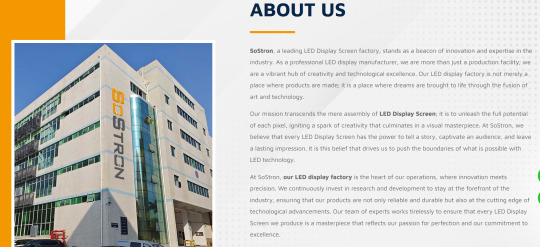
Summary: LED display screen, the enterprise's "eye-catching" magic tool
From brand exposure to precise marketing, from energy conservation and environmental protection to global competitiveness, LED displays provide enterprises with multi-dimensional value. The continued growth of global market data confirms its irreplaceable position. For companies that want to break through in the digital age, investing in LED displays is not only a technological upgrade, but also a strategic leap. Whether it is a small and medium-sized enterprise or an industry giant, LED screens can become your right-hand assistant to tell good brand stories and win market opportunities.
Take action now and use LED displays to light up your brand’s future!
Thank you for watching. I hope we can solve your problems. Sostron is a professional LED display manufacturer. We provide all kinds of displays, display leasing and display solutions around the world. If you want to know: Conference room LED display: Improve corporate collaboration efficiency. Please click read.
Follow me! Take you to know more about led display knowledge.
Contact us on WhatsApp:https://api.whatsapp.com/send?phone=+8613510652873&text=Hello
0 notes
Text
Computer Screen Market: Forecasting Market Value and Volume Trends 2025–2032

MARKET INSIGHTS
The global Computer Screen Market size was valued at US$ 43.67 billion in 2024 and is projected to reach US$ 62.84 billion by 2032, at a CAGR of 4.6% during the forecast period 2025-2032. The U.S. market accounted for 32% of global revenue in 2024, while China is expected to witness the fastest growth at 6.1% CAGR through 2032.
Computer screens are visual display units that present digital information through various display technologies. These include Liquid Crystal Displays (LCD), Light Emitting Diode (LED) panels, and emerging technologies like OLED and Mini-LED. Screens vary by size (typically 15-32 inches for standard use), resolution (HD to 8K), and specialized features such as high refresh rates for gaming or color accuracy for professional use.
The market growth is driven by increasing demand for high-resolution displays in both consumer and commercial sectors, alongside rapid technological advancements. The gaming industry's expansion and the shift to remote work have particularly boosted demand for premium displays. Major manufacturers like Samsung, LG, and Dell are investing in next-gen technologies, with Samsung recently introducing quantum dot-enhanced OLED screens in Q1 2024. However, supply chain challenges and fluctuating panel prices present ongoing market constraints.
MARKET DYNAMICS
MARKET DRIVERS
Rising Demand for High-Resolution Displays to Accelerate Market Expansion
The computer screen market is witnessing robust growth driven by the increasing demand for high-resolution displays across professional and consumer sectors. With 4K and 8K displays becoming mainstream, manufacturers are aggressively investing in advanced panel technologies to meet evolving user expectations. The proliferation of content creation, gaming, and graphic-intensive applications has fueled the adoption of premium displays with higher refresh rates, wider color gamuts, and superior contrast ratios. Notably, gaming monitors alone accounted for over 30% of global display shipments last year, reflecting strong momentum in this segment.
Work-from-Home Trends Continue to Stimulate Market Demand
The global shift toward hybrid work models has created sustained demand for computer monitors, with home office setups driving multiple monitor configurations. Corporate IT procurement policies increasingly include high-quality displays as standard equipment, while individual consumers upgrade home workspaces with ergonomic solutions. This trend shows no signs of slowing, with monitor purchases for remote work expected to maintain a double-digit growth rate through 2025. Additionally, the commercial sector's ongoing digital transformation initiatives continue to generate replacement demand across enterprises.
Technological Advancements in Display Panel Manufacturing Fuel Innovation
Manufacturers are pushing the boundaries of display technology with innovations in mini-LED backlighting, OLED panel production efficiencies, and quantum dot enhancements. These advancements enable higher brightness levels, better energy efficiency, and improved lifespan—critical factors for both enterprise and consumer adoption. Recent breakthroughs in manufacturing yields have allowed leading brands to introduce premium features at increasingly competitive price points, democratizing access to cutting-edge display technologies across market segments.
MARKET RESTRAINTS
Supply Chain Disruptions Create Manufacturing Bottlenecks
The computer screen market continues grappling with supply chain volatility affecting critical components like display panels and driver ICs. Recent semiconductor shortages have caused production delays and inventory imbalances across the industry, leading to extended lead times for premium models. These constraints are particularly acute for high-end gaming and professional displays that require specialized components. While capacity expansions are underway, complete supply chain normalization remains sluggish due to geopolitical factors and raw-material price fluctuations.
Intensifying Price Competition Squeezes Manufacturer Margins
Fierce competition among display manufacturers has led to aggressive pricing strategies, especially in the mainstream monitor segment. This price erosion is compressing profit margins despite rising component costs, forcing brands to optimize production efficiencies and shift toward higher-value product categories. The commoditization of basic LCD panels has particularly impacted vendors lacking differentiated technology portfolios, creating consolidation pressures across the supply chain.
Long Replacement Cycles Limit Upgrade Opportunities
Unlike smartphones with relatively short renewal periods, computer monitors typically have lifecycles exceeding five years in corporate environments and three-plus years among consumers. This extended replacement cadence creates challenges for manufacturers seeking sustained growth, requiring continuous innovation to stimulate premature upgrades. The durability of modern LCD panels further exacerbates this challenge, as users perceive less urgency to replace functioning displays lacking compelling new features.
MARKET CHALLENGES
Increasing Environmental Regulations on Hazardous Materials
The display industry faces mounting regulatory pressure concerning hazardous substances used in panel manufacturing. New directives restricting substances like mercury and certain flame retardants require significant reformulation of materials and manufacturing processes. Compliance with evolving global standards adds complexity to product development cycles while increasing testing and certification costs—challenges particularly acute for smaller manufacturers with limited R&D resources.
Technical Complexity of Next-Generation Display Technologies
The transition to advanced display technologies presents substantial engineering challenges. Yield rates for OLED and microLED panels remain below optimal levels, hindering mass production scalability. Thermal management, driver IC integration, and quality control issues continue complicating the commercialization of cutting-edge displays. These technical hurdles require substantial capital investment—potentially delaying widespread adoption of next-generation screen technologies.
Regional Market Fragmentation Increases Operational Complexity
Diverging consumer preferences across geographic markets necessitate extensive product customization and localized marketing strategies. Variations in power standards, connectivity norms, and aesthetic preferences create inventory management challenges for global manufacturers. Additionally, trade policies and tariffs introduce unpredictability in cross-border operations, requiring agile supply chain configurations that add cost burdens.
MARKET OPPORTUNITIES
Untapped Potential in Emerging Markets
Developing economies represent substantial growth opportunities as digital transformation accelerates across education, government, and commercial sectors. Rising middle-class populations with increasing disposable incomes are driving first-time PC and monitor purchases—a trend likely to sustain demand growth for years to come. Local assembly initiatives in these regions also offer cost advantages for manufacturers establishing regional production footholds.
Enterprise Digital Signage Presents New Vertical Opportunities
The convergence of computer displays and digital signage solutions creates new revenue streams for display manufacturers. Corporate environments increasingly adopt interactive displays for collaboration spaces, wayfinding systems, and information kiosks. These applications require specialized features like touch integration, high brightness for ambient light conditions, and robust mounting solutions—specializations enabling premium pricing and recurring revenue opportunities.
Healthcare and Education Sectors Drive Specialized Display Demand
The healthcare industry's transition to digital imaging creates strong demand for medical-grade displays with exceptional color accuracy and resolution. Similarly, education technology investments are fueling adoption of interactive flat panels and digital whiteboards. These specialized applications command higher margins than conventional office monitors while fostering long-term institutional relationships—a strategic priority for display manufacturers diversifying their customer base.
COMPUTER SCREEN MARKET TRENDS
Surge in Ultra-High-Definition Displays to Drive Market Expansion
The computer screen market is undergoing a significant transformation with the rapid adoption of ultra-high-definition (UHD) displays, including 4K and 8K resolutions. These advanced screens cater to professionals in graphic design, video editing, and gaming who demand superior clarity and color accuracy. The global UHD display market is expected to grow at a CAGR of over 15% in the next five years, fueled by increasing consumer preference for high-resolution displays. Manufacturers are also integrating OLED and Mini-LED technologies, which offer deeper blacks, higher contrast ratios, and improved energy efficiency compared to traditional LCD panels.
Other Trends
Gaming-Centric Displays Gaining Momentum
The rise of esports and PC gaming has created substantial demand for high-refresh-rate monitors, with 144Hz and 240Hz displays becoming industry standards. Curved screens, which enhance immersion, now account for nearly 20% of premium monitor sales. Features like NVIDIA G-Sync and AMD FreeSync synchronization technologies have become critical selling points, reducing screen tearing and improving gameplay fluidity. The gaming monitor segment is projected to grow at nearly twice the rate of the overall computer screen market through 2030.
Hybrid Work Environments Boosting Monitor Sales
The post-pandemic shift to hybrid work models has significantly increased demand for home office setups, with multiple monitor configurations becoming commonplace. Sales of 27-inch and larger screens have grown by over 30% since 2020 as professionals opt for more screen real estate. Eye-comfort features like blue light reduction and flicker-free technology are now standard in mid-range offerings. Additionally, the integration of USB-C connectivity allows single-cable solutions for both power and data transmission, simplifying workstation setups.
Computer Screen Market: Competitive Landscape
Key Industry Players
Innovation and Strategic Expansion Drive Competition in Display Technologies
The global computer screen market exhibits a semi-consolidated competitive landscape, dominated by multinational technology corporations while leaving room for specialized manufacturers. According to recent market data, the top five players accounted for over 45% of total 2024 revenue, demonstrating significant market concentration among industry leaders.
Samsung Electronics maintains a dominant position through its vertical integration strategy and comprehensive display technology portfolio, ranging from standard LCDs to cutting-edge OLED panels. The company's continuous investments in quantum dot technology and flexible displays have strengthened its competitive edge in both consumer and professional segments.
Meanwhile, LG Corp and TPV Technology have captured substantial market share through differentiated product strategies. LG's leadership in OLED manufacturing technology for high-end monitors and TPV's cost-optimized production for volume markets illustrate the diverse approaches to competing in this space. Both companies have recently expanded their production capacities to meet growing demand from both home and commercial sectors.
Emerging competition comes from Chinese manufacturers like AOC International and ViewSonic, which are gaining traction through aggressive pricing strategies combined with improving technological capabilities. These players are particularly strong in Asia-Pacific growth markets, where demand for affordable computing solutions continues to rise.
The market anticipates further disruption as Dell, HP, and Lenovo integrate their display businesses more closely with their computing hardware ecosystems. This vertical integration strategy allows these players to offer optimized end-to-end solutions, particularly for enterprise and professional users where display-performance synchronization is critical.
List of Key Computer Screen Manufacturers
Samsung (South Korea)
TPV Technology (China)
Apple Inc. (U.S.)
Intel Corporation (U.S.)
HP Inc. (U.S.)
LG Corp (South Korea)
Lenovo Group (China)
Dell Technologies (U.S.)
ASUSTeK Computer (Taiwan)
Acer Inc. (Taiwan)
ViewSonic Corporation (U.S.)
BenQ Corporation (Taiwan)
AOC International (Taiwan)
Philips (Netherlands)
GIGABYTE Technology (Taiwan)
Segment Analysis:
By Type
LCD Segment Dominates Due to Cost-Effectiveness and Widespread Adoption
The market is segmented based on display technology into:
Liquid Crystal Display (LCD)
Subtypes: TN, IPS, VA panels
Light Emitting Diode Display (LED)
Subtypes: Mini-LED, Micro-LED
OLED
Subtypes: AMOLED, PMOLED
Quantum Dot Display
Others
By Application
Commercial Segment Leads Due to High Demand in Offices and Public Spaces
The market is segmented based on application into:
Home
Commercial
Subtypes: Office, Retail, Education
Gaming
Professional
Subtypes: Graphic design, Medical imaging
Others
By Screen Size
22-27 Inches Segment Leads Due to Optimal Desktop Usage
The market is segmented based on screen size into:
Below 22 inches
22-27 inches
28-32 inches
Above 32 inches
By Resolution
Full HD Segment Maintains Dominance Due to Balanced Performance and Affordability
The market is segmented based on resolution into:
HD (720p)
Full HD (1080p)
QHD (1440p)
4K UHD
8K UHD
Regional Analysis: Computer Screen Market
North America North America remains a key player in the global computer screen market, driven by high disposable income, advanced technology adoption, and strong demand for premium displays. The U.S. accounts for the largest market share in the region, with growing demand for 4K, OLED, and gaming monitors, particularly from professional and gaming sectors. Companies like Dell, HP, and Apple dominate the premium segment, while mid-range displays from Samsung and LG see high adoption in enterprise and home offices. The shift to hybrid work models post-pandemic has further increased demand for high-resolution screens with ergonomic designs. However, market saturation in the consumer segment and price sensitivity pose challenges.
Europe Europe exhibits steady growth in the computer screen market, supported by rising demand for energy-efficient displays and strict EU regulations on electronic waste and energy consumption. Germany and the U.K. lead in adoption due to strong work-from-home and gaming sectors, while France and Italy focus on sustainable manufacturing and recyclability. The market sees increased competition between Asian and European brands, with companies like Philips and Acer expanding their gaming and professional monitor lineups. Despite economic uncertainties affecting discretionary spending, the shift toward higher refresh rates and HDR displays in professional and creative industries fuels growth.
Asia-Pacific Asia-Pacific is the fastest-growing region, driven by China, South Korea, and India, which together account for over 50% of global screen production. China leads in both manufacturing and consumption, with companies like TPV Technology, Samsung, and LG dominating supply chains. Demand is fueled by rising IT infrastructure, gaming culture, and corporate digitization efforts. India shows significant growth in budget monitors, while Japan favors high-end IPS and OLED displays for professional use. The region also faces intense price competition, pushing manufacturers to balance cost efficiency with advanced features.
South America South America presents emerging opportunities, with Brazil and Argentina as primary markets. Demand is driven by increasing internet penetration and remote work trends, though economic volatility limits high-end adoption. Consumers favor budget LCD screens, with brands like AOC and Lenovo gaining traction. Import restrictions and local manufacturing incentives are reshaping supply chains, but currency fluctuations and logistics challenges hinder consistent growth.
Middle East & Africa The Middle East & Africa market is nascent but promising, with Saudi Arabia, UAE, and South Africa as key growth hubs. Demand is rising in corporate and public sector digitization projects, supported by government initiatives toward smart cities. While gaming and high-end displays remain niche, affordable monitors from Chinese and Taiwanese brands dominate. Limited local production and reliance on imports create pricing hurdles, though infrastructure investments indicate long-term potential.
Report Scope
This market research report provides a comprehensive analysis of the Global and regional Computer Screen markets, covering the forecast period 2025–2032. It offers detailed insights into market dynamics, technological advancements, competitive landscape, and key trends shaping the industry.
Key focus areas of the report include:
Market Size & Forecast: Historical data and future projections for revenue, unit shipments, and market value across major regions and segments. The global Computer Screen market was valued at USD million in 2024 and is projected to reach USD million by 2032.
Segmentation Analysis: Detailed breakdown by product type (LCD, LED), technology, application (home, commercial), and end-user industry to identify high-growth segments and investment opportunities.
Regional Outlook: Insights into market performance across North America, Europe, Asia-Pacific, Latin America, and the Middle East & Africa, with the U.S. market size estimated at USD million in 2024 and China projected to reach USD million.
Competitive Landscape: Profiles of leading market participants including Samsung, LG Corp, Dell, HP, and Lenovo, covering their product offerings, market share, and recent developments.
Technology Trends & Innovation: Assessment of emerging display technologies, integration of smart features, and evolving industry standards in screen manufacturing.
Market Drivers & Restraints: Evaluation of factors driving market growth along with challenges in supply chain, raw material availability, and regulatory compliance.
Stakeholder Analysis: Insights for component suppliers, OEMs, retailers, investors, and policymakers regarding the evolving display technology ecosystem.
Primary and secondary research methods are employed, including interviews with industry experts, data from verified sources, and real-time market intelligence to ensure the accuracy and reliability of the insights presented.
FREQUENTLY ASKED QUESTIONS:
What is the current market size of Global Computer Screen Market?
-> Computer Screen Market size was valued at US$ 43.67 billion in 2024 and is projected to reach US$ 62.84 billion by 2032, at a CAGR of 4.6% during the forecast period 2025-2032.
Which key companies operate in Global Computer Screen Market?
-> Key players include Samsung, LG Corp, Dell, HP, Lenovo, Apple, Asus, Acer, ViewSonic, and BenQ, among others.
What are the key growth drivers?
-> Key growth drivers include increasing demand for high-resolution displays, growth in gaming and entertainment sectors, and rising adoption of multiple monitor setups.
Which region dominates the market?
-> Asia-Pacific is the largest market, driven by manufacturing hubs in China and South Korea, while North America remains a key innovation center.
What are the emerging trends?
-> Emerging trends include OLED technology adoption, higher refresh rate displays, and integration of smart features like built-in webcams and touch capabilities.
Related Reports:https://semiconductorblogs21.blogspot.com/2025/06/binary-gas-analyzer-market-size-share.htmlhttps://semiconductorblogs21.blogspot.com/2025/06/inverted-light-microscopy-market.htmlhttps://semiconductorblogs21.blogspot.com/2025/06/insulating-functional-devices-market.htmlhttps://semiconductorblogs21.blogspot.com/2025/06/multi-core-computer-processors-market.htmlhttps://semiconductorblogs21.blogspot.com/2025/06/power-factor-correction-choke-market.htmlhttps://semiconductorblogs21.blogspot.com/2025/06/tunable-ultrafast-source-market-key.htmlhttps://semiconductorblogs21.blogspot.com/2025/06/solid-state-remote-power-controller.htmlhttps://semiconductorblogs21.blogspot.com/2025/06/panel-interface-connector-market.htmlhttps://semiconductorblogs21.blogspot.com/2025/06/semiconductor-process-components-market.htmlhttps://semiconductorblogs21.blogspot.com/2025/06/automotive-high-mount-stop-light-market.htmlhttps://semiconductorblogs21.blogspot.com/2025/06/indium-antimonide-detector-alarm-market.htmlhttps://semiconductorblogs21.blogspot.com/2025/06/din-rail-mounted-thermocouple-terminal.htmlhttps://semiconductorblogs21.blogspot.com/2025/06/hbm2-dram-market-competitive-landscape.htmlhttps://semiconductorblogs21.blogspot.com/2025/06/aptamer-based-quartz-crystal.htmlhttps://semiconductorblogs21.blogspot.com/2025/06/helium-neon-laser-tubes-market-analysis.htmlhttps://semiconductorblogs21.blogspot.com/2025/06/semiconductor-structural-components.htmlhttps://semiconductorblogs21.blogspot.com/2025/06/optical-power-and-energy-market-size.html
0 notes
Text
Key Points of Industrial Control & Outdoor High-Brightness LCD Screens
Industrial control LCD screens are specialized displays designed for demanding environments, with features like wide temperature tolerance (−30°C to +80°C) and high brightness (over 400 nits), ensuring clear visibility under strong light. These are widely used in instrumentation, communication equipment, automation, and outdoor systems.
Analog vs. Digital LCD Panels:
LCD screens differ based on their driver circuits:
Analog input uses a D-SUB interface and converts RGB analog signals to digital within the display.
Digital input uses DVI or similar interfaces, offering better signal integrity and sharper images.High-quality lcd display modules often support both, enhancing compatibility.
Internally, all LCDs operate digitally; the difference lies in how signals are received and processed.
Outdoor High-Brightness LCD Advantages:
Expanding Business Opportunities:
Outdoor lcd display screens are widely adopted in high-traffic areas—airports, malls, museums, metro stations—for advertising and information display. Their clarity, vivid colors, and sunlight readability make them more effective than traditional LED screens.
Low Environmental Impact:
Modern lcd panels minimize radiation and visual pollution, offering a cleaner, safer viewing experience. Customizable solutions adapt to various installations without overwhelming the environment.
Conclusion:
With their durability, clarity, and low energy footprint, industrial and outdoor tft lcd modules, lcd display panels, and touch lcd screens offer powerful display solutions across industries.
Shenzhen Zhiyan Optronics Co., Ltd. (zylcdshop.com) is a reliable China-based supplier with 18+ years of experience in high-performance LCD screens, offering quality products, customized solutions, and competitive factory-direct prices.
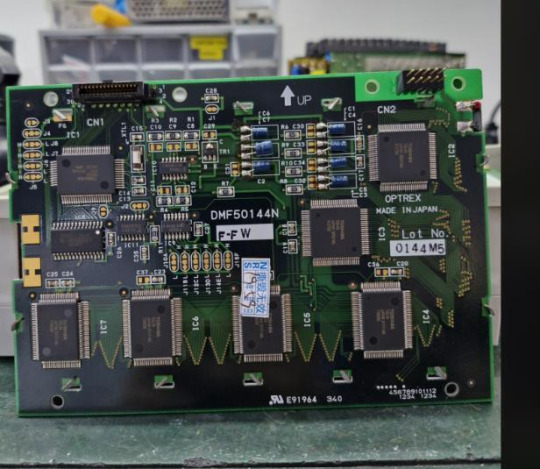
#lcd replacement screen#tft display module#display original#buy lcd panels#tft panel#truly lcd#lcd screen panel#wholesale lcd#replacement screen#wholesale lcd screen#lcd monitor panel#module lcd#tft lcd display module#7 inch display#lcd replacement panels#lcd panel display#display panel#lcd controller board#touch screen lcd display
0 notes